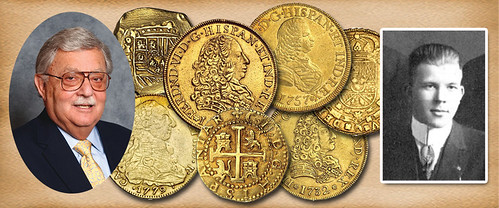
PREV ARTICLE
NEXT ARTICLE
FULL ISSUE
PREV FULL ISSUE
DISPOSING OF THE LILLY COLLECTIONIn a series of blog posts, Harvey Stack has been writing about his family's role in helping form the Josiah K. Lilly Collection. With Lilly's death in 1966 the goal switched
to one of helping the estate dispose of the collection. Here are excerpts from the latest installments (#30,31) -Editor
 In early August of 1966, my cousin Norman Stack and I went to Indianapolis to work on the inventory. Norman had not seen all the coins we sold Mr. Lilly from 1951 to 1955 as he had been in the military stationed in Germany most of that time. Of course, when the collections were seen in total, it was amazing. Special black box after black box, each holding up to 144 gold coins, were brought into the large conference room at the bank, and we worked constantly for almost three full days. We had to verify the inventory, which would eventually be typed on a listing so that the appraisers and the bank had reference material. As noted, Norman had not seen much of the collection. He had never seen the sets of $1, $2.50, $3, and $4 gold, we got from the Anderson DuPont collections. He was aware of the Clifford Weihman $5 and $10 gold coins, but had not seen them for a decade or more when we had them at Stack's. And he had never seen the double eagles, a set that was also almost complete. The basic collection of pioneer and Territorial coins was also new for him to see. Of course, he was part of the team after 1955 and was aware of the items that had been acquired after that time. As a numismatist who understood the importance of completeness and quality, he was amazed at what Stack's and Mr. Lilly had been able to amass. Using a file card system we developed for the Lilly collection, Norman and I spent several days checking off each coin. A few times they were out of order, or in another tray (the coins that measured over two inches in diameter did not fit in the standard trays). It was a revealing job for Norman and an exciting job for me. It was a wonderful opportunity to see once again the collection in total! A few weeks after we visited the collection in the bank vault we had the inventory typed so it could be used by the appraisers for computing the total value of the collection. Hans Schulman and Abe Kosoff were the appraisers, following the suggestions we gave to Paul Rawley. With the information included in our inventory (including pedigree and source of acquisition) as well as our examination of each and every coin, the job of appraising was made somewhat easier for them. Yet, the appraisal by Kosoff and Schulman took longer than expected. Each took time to check and research each item; many were so rare that it took much time to find the reference material and check auction records. In some cases they had to go back a decade or more to provide the information required for the estate. About five months after we submitted the inventory, Kosoff and Schulman submitted their appraisals. After his passing, and with the permission of Mr. Rawley, we were permitted to use the Lilly name in advertising. Before then, Stack's had kept the identity of Josiah K. Lilly a secret, as this is how Mr. Lilly wanted it. In the fall of 1966 we placed a series of ads that were worded like this: “The secret that isn’t secret anymore! For 16 years (1951 to 1966) Stack’s was secretly building the most outstanding collection of United States, foreign and ancient gold coins ever assembled in the United States if not the world! "It was formed by the late Josiah K. Lilly, who dedicated his collecting skills and avocation to forming a world class gold coin collection. Stack’s is proud that Mr. Josiah K. Lilly selected us to help him collect and develop this collection.” After the ads appeared we received numerous calls about the final disposition of this superb collection. We responded that it would be determined later. One of the calls came from curator of the Smithsonian National Numismatic Collection, Dr. Vladimir Clain-Stefanelli. He asked if we could get him an invitation to examine the collection and even to record the contents. He was invited to see it, and he did so, accompanied by his wife, Elvira, who was also a curator of the National Collection. They worked for several days, making notes and commenting that they had not known or heard of a collection of this scope and quality ever formed in the world. Their basic opinion was that the collection was so extensive and of such great quality, scope and value, that it should not be broken up but should be kept together, possibly through it being acquired by the Smithsonian. Wow! This was a great compliment, but somewhat of a disappointment as we were hoping to be awarded the sale by auction. If the collection was not to be placed on the numismatic market, Stack’s would lose the possibility of selling it. It would be available for study, examination, and comparison by students and collectors. But, no collectors would be able to add pieces to their collections. The question was: how would the government acquire this? To read the complete articles, see:
To read the earlier E-Sylum article, see:
 Wayne Homren, Editor The Numismatic Bibliomania Society is a non-profit organization promoting numismatic literature. See our web site at coinbooks.org. To submit items for publication in The E-Sylum, write to the Editor at this address: whomren@gmail.com To subscribe go to: https://my.binhost.com/lists/listinfo/esylum All Rights Reserved. NBS Home Page Contact the NBS webmaster 
|